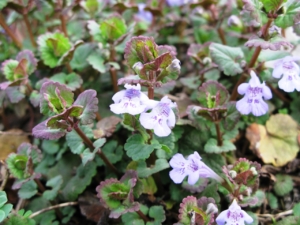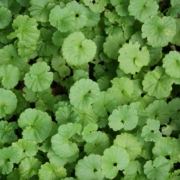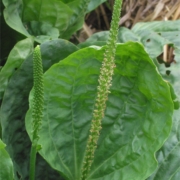Ground Ivy
This common, creeping perennial weed is something you’ve probably been cursing for years. It’s in everyone’s garden or lawn, and while it’s easy to pull up, its spreading nature keeps it on the annoying plant list for most people. And like most weeds, this one has an impressive amount of medicinal uses, including as a spring tonic to relieve seasonal allergies.
BOTANICAL NAME: Glechoma hederacea
COMMON NAMES: Ground Ivy, Creeping Charlie, Gill-Over-The-Ground, Alehoof, Cat’s Foot, Cat’s Paw, Gill-Go-By-The Hedge, Gillrun, Hay Maids, Hedge Maids, Lian Qian Cao, Lizzy-Run-Up-The-Hedge, Robin-Run-In-The-Hedge, Tun-Hoof, Turnhoof
FAMILY: Lamiaceae (Mint family)
PARTS USED: Leaves, flowers and tender stems
 BOTANICAL DESCRIPTION: The leaves are heart shaped, opposite, scalloped, and dark green, sometimes tinted purple. The main root is thick and matted it sends out runners up to several feet long. Considered an invasive. Flowers appear in March – April and are purplish to blue, two lipped and grow in axillary whorls of six. The plant is quite aromatic when picked. As a member of the mint family it has a square stem. The stems are finely haired.
BOTANICAL DESCRIPTION: The leaves are heart shaped, opposite, scalloped, and dark green, sometimes tinted purple. The main root is thick and matted it sends out runners up to several feet long. Considered an invasive. Flowers appear in March – April and are purplish to blue, two lipped and grow in axillary whorls of six. The plant is quite aromatic when picked. As a member of the mint family it has a square stem. The stems are finely haired.
GROWING/HARVESTING/PROCESSING: Ground ivy is a creeping European perennial evergreen, naturalized in North America and found in moist shady areas, along paths, around hedges, and roadsides from Ontario to deep south, west to Kansas, and along the Pacific Coast. Cultivation: it is easily cultivated through root division and thrives in moist shady areas. Gather leaves, flowers and stems year-round. Can be dried for later herb use.
ETHONBOTANY/FOLKLORE/HISTORY: Ground ivy has a long history of use in alternative medicine and as an edible herb, dating back to the first century A.D. it was long considered a panacea (cure-all). Known for its hi vitamin C content it is said to be one of the first herb and edible plants brought to the North American continent by early settlers. Ground ivy was widely used by the Saxons instead of Hops in the production of ale, hence the name alehoof. Maude Grieve is of the opinion that this was because it improved the flavor and keeping qualities of the beer and also because it made the final drink clearer.
It also has a long reputation as an excellent tisane herb, where a tea is made from the herb which is then sweetened with honey, sugar or licorice and allowed to cool. It was often sold on the streets in Elizabethan England under the name ‘Gill Tea’. It was used in this era as a blood purifier. Interestingly, ‘Gill Tea’ was the name of the drink made by boiling together Ground Ivy and young Nettle shoots and drinking it for 9 consecutive days in the spring. This remedy was used to clear up skin complaints as well as in the form of a spring tonic.
ENERGETICS AND TASTE: light, astringent, aromatic, slightly bitter, cooling.
CHEMICAL CONSTITUENTS: Essential oils (limonene and menthone), flavonoids, triterpenes (alpha and beta ursolic acids and oleanolic acid), marrubiin which is a diterpene, and polyphenolic acids (rosmarinic acid), Vitamin C
ACTIONS AND PROPERTIES: Diuretic, astringent, nervine, anti-allergenic/antihistaminic, anti-inflammatory, antibacterial, antioxidant, antiseptic, antispasmodic, antiviral, expectorant, immune stimulant, sedative.
INDICATIONS: Ground ivy is an excellent spring tonic. It contains a volatile oil which aids in relieving congestion and inflammation of mucous membranes associated with colds, flu, and sinusitis and it can stimulate appetite.
- Kidneys & Urinary System – a gentle diuretic and urinary tonic, ground ivy can be used for bladder infections, cystitis, renal inflammation, hematuria and kidney stones.
- Respiratory System – This herb has a wide variety of uses for the respiratory tract, including in the treatment of coughs and colds, sinusitis, catarrh, asthma, bronchitis, nervous coughs, pertussis and tuberculosis.
- Digestive System – Used to treat gastritis and acid indigestion as well as gastrointestinal ulcers, and to treat diarrhea and dry up mucous secretions (good for mucus colitis, but not great for dry stools). It can also be used as part of a formula to treat dyspepsia, obstructive jaundice, IBS and hemorrhoids as a fresh juice or tea made from the dried herb.
- Topical applications – Topically, ground ivy can be used to relieve sinus infections (as a steam) and ear infections (as an infused oil). As a lotion or wash to it can treat lice, abscesses, itchy skin and eczema. Added to bath as an emollient to soften skin and has a sedative effect.
- Other – The herb also has a reputation as a useful nervine, particularly in the treatment of tension headaches. It has been used to bring down retained placentas, to tone female reproductive system, and for glandular problems. It is being studied for use in preventing leukemia, many kinds of cancer, and HIV. Although results are not conclusive it is being used as an antidote for lead poisoning.
CONTRAINDICATIONS: Do not use in excessively dry conditions – Ground Ivy can be very drying and would not suit people with an overly hot, dry disposition. Small doses of this powerful plant are recommended. (Potts). Reportedly toxic to horses and one case of human toxicity reported (Duke).
PREPARATION AND DOSAGE: Soluble in water, alcohol. Use as a tea, tincture, infused oil, bath, steam or compress.
Ground ivy tea or juice is well tolerated and can be given to small children. The dosage for ground ivy is 2-4g dried herb or equivalent liquid extract three times per day.
Recipe for colds and flu: Express fresh juice with press. Take 1 tsp. 3 times a day, ½ tsp. for children. Use 2 or 3 drops in nose twice a day for sinusitis. 3-5 drops of tincture daily is used for toning the female reproductive system.
REFERENCES:
- http://www.altnature.com/gallery/Ground_Ivy.htm
- www.botanical.com A Modern Herbal, Maude Grieve
- http://www.rowanremedies.com/healing/glechoma-hederacea-ground-ivy/
- Witches Heal, Billie Potts.
- Medicinal Plants and Herbs, Steven Foster and James Duke




 DESCRIPTION:
DESCRIPTION: 


